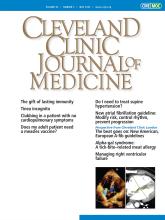Article Figures & Data
Tables
Co-infection and secondary bacterial infection • Viral co-infection incidence varies based on case series (0% to 15%)2–7 • Combine bacterial and viral infection is rare in COVID-19 patients3,8–10 • Secondary bacterial infection is not uncommon and leads to significant morbidity and mortality, especially in the elderly4,9,16 Procalcitonin • Detectable in 2 to 4 hours, peaks at 12 to 24 hours, and has a half-life of 25 to 30 hours • Levels are normal (< 0.5 μg/L) in COVID-19 patients with mild disease and may be elevated (≥ 0.50 μg/L) in patients with severe disease10,14 • Elevated levels are correlated to a nearly 5-fold higher risk for severe SARS- CoV-2 infection17 • Elevated levels are not specific to bacterial infection because they can also be raised in patients with acute respiratory distress syndrome, end-stage renal disease, cardiogenic shock, and multi-organ failure18 • A normal level makes bacterial infection less likely and can guide antibiotic discontinuation19,20 • In bacterial infection, levels may be less affected by IL-6 inhibitors than C-reactive protein (CRP)21–23 CRP, Erythrocyte sedimentation rate (ESR) • CRP and ESR are non-specific inflammatory markers. Both are generally elevated in COVID-19 and are therefore not helpful in differentiating this from bacterial infection • Tocilizumab rapidly reduces CRP and leukocytosis and may suppress fever24–26 Typical radiographic features COVID-19 • Chest radiography: Bilateral, peripheral, lower-zone predominant air-space disease27 • Computed tomography: Bilateral, predominantly peripheral ground glass opacities, crazy-paving and consolidation28; findings vary based on stage/phase of the disease Bacterial pneumonia • Chest radiography: Lobar or segmental air-space opacification ± air bronchograms • Computed tomography: Segmental or lobar focal dense consolidation ± ground-glass opacities






